Grain-free cat food has gained popularity over the past few years as many pet owners look for diets that mimic what their cats would naturally eat in the wild. While some believe grain-free diets can improve a cat’s overall health, there is still debate about their benefits and potential drawbacks. In this article, we’ll explore the pros and cons of grain-free cat food to help you make an informed decision for your feline companion.
The Pros of Grain-Free Cat Food
1. Better for Cats with Grain Sensitivities or Allergies
Some cats have food sensitivities or allergies to grains like corn, wheat, or soy. For these cats, a grain-free diet may help alleviate symptoms such as digestive upset, itchy skin, and ear infections. Grain-free cat food often uses alternative carbohydrate sources like sweet potatoes, peas, and lentils, which are less likely to cause allergic reactions in sensitive cats.

2. High-Quality Protein Sources
Many grain-free cat foods feature high-quality animal proteins like chicken, turkey, or fish as the primary ingredient. Since cats are obligate carnivores, they need animal-based protein to thrive. A grain-free diet often emphasizes these protein-rich ingredients, which can support muscle development, energy, and overall health.
3. Better Digestion for Some Cats
Cats with sensitive digestive systems may benefit from a grain-free diet. Since grains can be harder to digest for some cats, removing them from the diet can reduce the risk of bloating, diarrhea, or vomiting. Grain-free foods often contain more digestible carbohydrate alternatives, which may be gentler on a sensitive stomach.
4. Weight Management
Some grain-free cat foods are lower in carbohydrates than traditional kibble, which can be beneficial for overweight or obese cats. Lower carb content means less potential for weight gain, and some grain-free formulas focus on balanced nutrition to promote a healthy weight while still providing the protein and fat a cat needs.
The Cons of Grain-Free Cat Food
1. Potential for Nutrient Imbalance
While grain-free diets are often high in protein, they may lack certain essential nutrients that grains would provide. Some grain-free formulas might not have the right balance of vitamins, minerals, and fatty acids required for a cat’s overall health. In some cases, the absence of grains can lead to nutritional gaps, so it’s important to choose a high-quality grain-free food with a complete nutrient profile.
2. Increased Risk of Heart Disease (Dilated Cardiomyopathy)
Recent studies have raised concerns about a potential link between grain-free diets and heart disease, particularly dilated cardiomyopathy (DCM) in cats. While the cause of DCM is not fully understood, some research suggests that grain-free diets, which are higher in legumes like peas, lentils, and chickpeas, may contribute to taurine deficiency. Taurine is an essential amino acid that supports heart health, and its deficiency can lead to DCM. Although this link is still being studied, it’s something to consider when choosing a grain-free diet for your cat.
3. Not Necessary for All Cats
Many cats can tolerate grains without any issues. In fact, some commercially available cat foods with grains can provide balanced nutrition, including important vitamins and minerals like B vitamins and fiber. If your cat doesn’t have a sensitivity to grains or allergies, a grain-free diet may not offer significant benefits and could even be more expensive than regular food.
4. Cost and Availability
Grain-free cat foods tend to be more expensive than traditional cat food that contains grains. The ingredients used in grain-free diets, like high-quality animal protein and alternative carbohydrates, often come at a premium price. If you’re on a budget, the cost of switching to a grain-free diet might be a concern. Additionally, not all pet stores carry a wide variety of grain-free options, making it harder to find the right food for your cat.

5. High Carbohydrate Content in Some Grain-Free Foods
While grain-free diets typically replace grains with other carbohydrate sources, some grain-free cat foods still contain a significant amount of carbohydrates. Ingredients like potatoes, sweet potatoes, and peas can be rich in starch, and high carbohydrate content may not be ideal for all cats, especially those prone to obesity or diabetes. Always check the ingredient list to ensure the carbohydrate content aligns with your cat’s dietary needs.
Conclusion
Grain-free cat food offers benefits for cats with grain allergies, sensitivities, or digestive issues, and it often emphasizes high-quality animal proteins. However, there are potential downsides, including the risk of nutrient imbalances, the possibility of contributing to heart disease, and the fact that it may not be necessary for all cats. If you’re considering switching to a grain-free diet for your cat, it’s essential to consult your veterinarian, especially if your cat has any underlying health concerns. A vet can help guide you in choosing the best food based on your cat’s specific needs and health profile.
